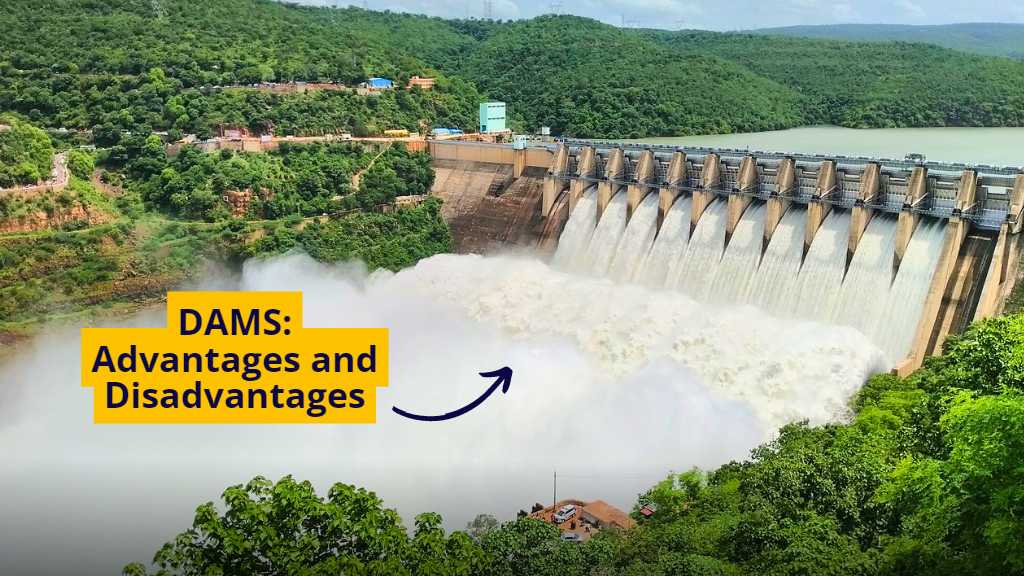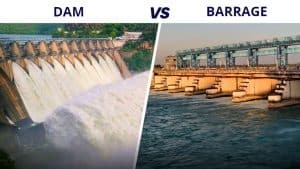
Advantages and Disadvantages of Dams: A Detailed Discussion
Dams, engineering marvels that tame the flow of rivers and harness the force of water, have played a vital role in meeting the diverse needs of societies throughout history. These structures have been created to store and regulate water, providing a multitude of benefits to human communities and the environment. From generating clean energy and managing water resources to mitigating flood risks and facilitating agricultural development, dams have shaped landscapes and transformed the way we live.
However, these benefits do not come without their fair share of trade-offs. In this article, we will delve deeper into the advantages and disadvantages of dams in detail. Let’s get started.
4 Advantages and Disadvantages of Dams
Let’s start with the advantages first.
1. Hydropower Generation
Hydropower is a renewable energy source as it relies on the continuous flow of water, typically from rivers. Unlike fossil fuels, it does not generate greenhouse gas emissions during power generation, making it a clean and environmentally friendly option. Dams can store water in reservoirs and release it as needed, allowing for a consistent and predictable energy supply, unaffected by weather conditions.
Hydropower projects can be designed to accommodate various scales, from small-scale micro-hydropower systems to large-scale dam projects. This flexibility makes it adaptable to different energy demands and provides options for localized energy production or significant power generation for regional grids. Dams can provide baseload power, meaning they can generate a continuous supply of electricity throughout the day. This stability is beneficial for meeting the base demand of power grids and ensuring a consistent power supply to meet various energy needs.
2. Flood Control
By regulating water flow, dams can help mitigate the risk of flooding in downstream areas. During periods of heavy rainfall or snowmelt, dams can store excess water, preventing it from overwhelming downstream regions and reducing the chances of catastrophic floods.
Dams’ controlled release of water enables the gradual and controlled flow downstream. This helps to manage water levels and prevent sudden surges that could lead to flash floods.
3. Water Supply
Dams can store and supply water for drinking purposes after appropriate treatment. They provide a consistent source of clean water, ensuring access to safe drinking water for communities.
4. Irrigation
By providing a controlled water supply, dams support large-scale irrigation projects, allowing farmers to irrigate their fields and cultivate crops more efficiently. This improves agricultural productivity, enhances crop yields, and can contribute to food security.
Dams store water and release it during dry spells, facilitating large-scale irrigation projects. This supports agricultural activities by providing a reliable water supply for irrigation, leading to improved crop yields, enhanced food security, and the livelihoods of rural communities.
Disadvantages of construction of dams
1. Water Quality Concerns
Reservoir water can be susceptible to contamination from various sources, including agricultural runoff, industrial discharges, and urban pollutants. These contaminants can affect the water quality and require extensive treatment to meet drinking water standards. Proper monitoring and management are necessary to address potential water quality concerns.
Dams trap sediment and nutrients carried by rivers, leading to the accumulation of sediment in reservoirs. Over time, this can affect water quality, increase the risk of algal blooms, and impact the ecosystem within the reservoir. Depending on the level of contamination, treating water from reservoirs for drinking purposes can be more complex and expensive compared to treating water from other sources. Additional treatment processes, such as filtration, disinfection, and advanced technologies, may be required to ensure that the water is safe and meets quality standards.
2. Distribution Challenges
Distributing water from dams to communities requires a well-designed and maintained water distribution infrastructure. This includes pipelines, pumping stations, storage facilities, and treatment plants. Developing and maintaining such infrastructure can be costly, particularly in remote or underserved areas with challenging terrain or limited resources.
Ensuring equitable access to clean water for all communities can be challenging. Some remote or marginalized areas may face difficulties in accessing water due to the lack of proper distribution infrastructure. Achieving universal access to clean water requires addressing these disparities and ensuring that infrastructure reaches all communities, regardless of their location or socioeconomic status.
3. Environmental Impact
The construction of dams leads to the flooding of upstream areas, resulting in the loss of terrestrial habitats, including forests and wetlands. This alteration of natural habitats can negatively impact biodiversity, affecting plants, animals, and fish populations.
Dams alter the natural flow patterns of rivers, affecting the downstream ecosystems. Changes in water flow, temperature, sediment transport, and dissolved oxygen levels can disrupt aquatic habitats, affecting fish migration, spawning, and overall ecological balance.
4. Cost and Affordability
Dams require substantial investment for construction, including engineering works, materials, and labor. Additionally, ongoing maintenance and operation costs can be significant, including monitoring, repairs, sediment removal, and infrastructure upkeep. These costs can put a financial burden on responsible entities and impact the affordability of water services.
The costs associated with building, maintaining, and operating dams and water treatment facilities can be passed on to consumers, potentially resulting in higher water prices. This can be a challenge, particularly for low-income communities, where access to clean water at an affordable cost becomes a concern.
Final Thoughts – Advantages and Disadvantages of Construction of Dams
There are both advantages and disadvantages of dams. They generate clean energy, reduce flood risks, provide water for various purposes, and support agriculture. However, we must also consider their potential environmental impacts, water quality concerns, distribution challenges, and affordability issues. By finding a balance between utilizing dams and addressing these challenges, we can ensure sustainable water management for the well-being of current and future generations.
Advantages and Disadvantages of the Construction of Dams FAQ’s:
1. What is the major disadvantage of dams?
One of the major disadvantages of dams is their potential negative environmental impact. The construction and operation of dams can lead to several ecological consequences. These include the alteration of natural river ecosystems, disruption of water flow patterns, and the potential loss of habitats for various plant and animal species.
Dams can also impact fish populations by blocking their migration routes and altering their natural breeding and spawning patterns. Additionally, the formation of reservoirs behind dams can result in the submergence of large areas of land, leading to the loss of forests, wetlands, and other valuable terrestrial habitats. However, it is important to note that there are both advantages and disadvantages of the construction of dams.
2.
What are the failures of a dam?
Dams can experience failures, including structural failures, overtopping, foundation instability, and inadequate maintenance. These failures can result in breaches, collapses, and downstream flooding, posing risks to human life, property, and the environment.
3. What causes dam damage?
Dam damage can be caused by natural disasters, poor construction or design, aging infrastructure, lack of maintenance, sedimentation, and erosion. Additionally, human activities such as improper land use practices, mining operations, or unauthorized modifications to the dam can also contribute to dam damage.






